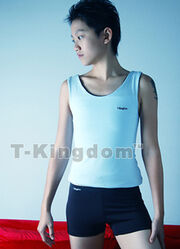
Binding is the act of pushing the breast tissue down to create the appearance of a flat chest. This may be to relieve gender dysphoria or body dysmorphia, partake in cosplay, medical reasons or simply a personal choice.
Using a Binder[]
A binder is something used to bind breasts to make them less noticeable to either yourself or others. Binders are often used amongst different FTM-transgender individuals, such as transsexuals, transvestites or drag kings. Neutrois or other non-binary individuals may wish to bind to appear more androgynous or neutral in their presentation.
When binding it can be useful to remember that even a flat chest in someone without breast development is not necessarily completely 'flat' and may be defined by muscle groups or simply the shape of their body.
Methods for Binding[]
There are many ways to bind although using a professional binder is often the safest. However, binders can be expensive and it is important to note that there are other methods that will safely serve the same purpose.
Professional Binder[]

Non-binary person wearing an Amor Binders Full Chest Racerback binder.
There are many types of professional binder. However, it is often a matter of personal preference for which style or type you choose. It is important that the binder is the right size for you and never layer two binders. When selecting a binder, try to source it from a reputable company that has good reviews. Unfortunately these may often cost more although it is important to weigh the financial loss against the binders performance and your own safety.
Sports Bra[]
A sports bra that is slightly smaller than one's typical cup will flatten the breast tissue to an extent. Another sports bra can be put on top of the first but backwards will allow you to achieve an even flatter chest.
Camisole[]
A camisole top with a built in bra can be effectively used to bind one's chest. These can be purchased at relatively low costs from many shops. Note that this method will not work as well for those with a larger chest measurement. To bind, put the camisole on backwards and adjust the straps so they are as short as possible. Then carefully fold up the camisole around two or three times until you feel comfortable with it. With this method one can quite safely put on another camisole over the top of the other and fold it again to achieve an appearance of further flatness.
Other Methods Aside from Binding[]
If you don't want to use any of these methods or are unable to, there are many ways to reduce the size of one's chest through illusion. Wearing several loose tops or shirts can reduce the apparent size of the breast tissue. Also, avoiding geometric or repetitive patterns can help; with random designs the eye is drawn away from the topology and towards the unpredictable nature of the pattern. Equally it is harder to see any shadows or shape due to the tissue below. Pockets on the material outside the breast can draw the eye's attention there so this may be something to avoid too. Wearing a dark or plain shirt or top and a coloured or patterned pair of trousers will again distract the eye's attention to the lower garments and avoid some awareness of the presence of breasts.
Associated Dangers[]
Binding is only a safe on a temporary basis and you should never bind for more than eight to the absolute maximum of twelve hours. Neither is it safe to sleep in a binder, or practice the technique over an extended amount of time. If you choose to bind, always make sure the binder or material you are using to bind is clean and allows for your skin to breathe. Binding can lead to a build up of fluid in the breasts or in some cases cracked ribs. If you feel yourself becoming faint or light headed, or struggling to breath because you are binding, remove anything restricting your breasts.
Although tape and ACE bandages have been widely circulated as possible ways of binding one's chest, they are incredibly dangerous. ACE bandages are designed to increase their pressure with movement and this when applied to the chest is unsafe because with each breath the bandage will increase the pressure on the ribs until it is tight enough to break ribs or prevent an intake of breath. Tape, clingfilm or any other materials not specifically designed for binding should be avoided. They do not allow for the skin to access the air and can rub repeatedly in some areas causing serious discomfort.
If you are considering binding or bind regularly, if it is appropriate or safe for you to do so, it is a good idea to tell a few trusted friends, colleagues or family members that you bind. Thus if a situation or complication develops, they can pass on the relevant details or provide support for you without the need for explanation.
Exercising in a binder is not recommended although some are developed with this in mind. Quite truthfully, it is simply a matter of examining a range across the market and selecting one that fits best to one's lifestyle and personal choices.
Accessing a Binder[]
Binders can be expensive, although in some countries schemes have been set up to enable young transgender or non-binary individuals access to second-hand, clean binders that people who have undergone top surgery no longer need.
If you discreetly wish to access a binder, do not have permission to buy one or are not in a situation where you can approach the subject for whatever reason, it can be useful to request that it can be sent to a friend's address from where you can collect it, although you should always check with them first. Some companies that sell binders allow for the use pseudonyms and offer the complete privacy of details.